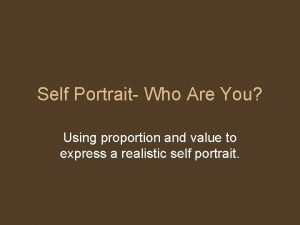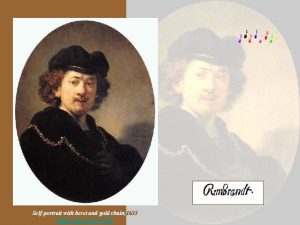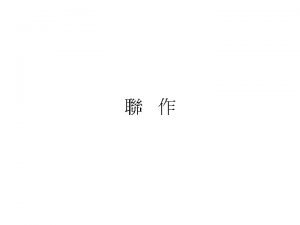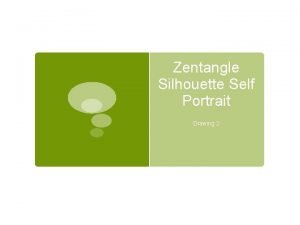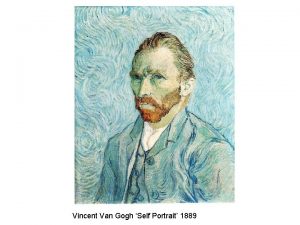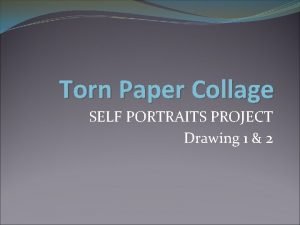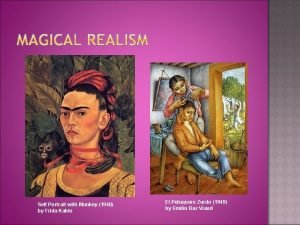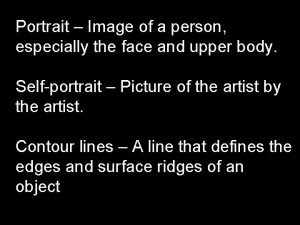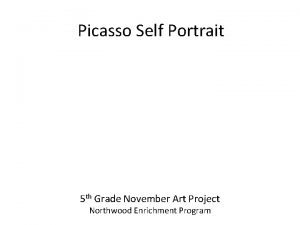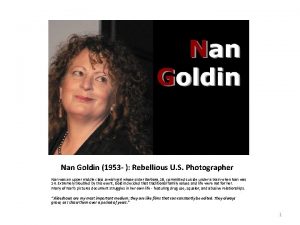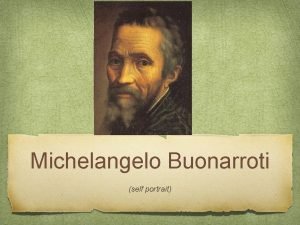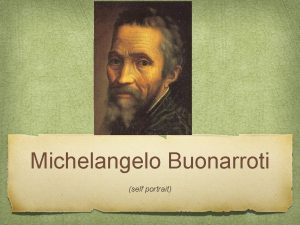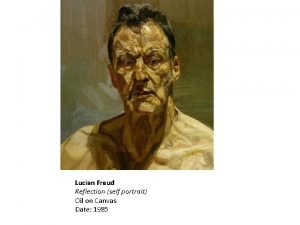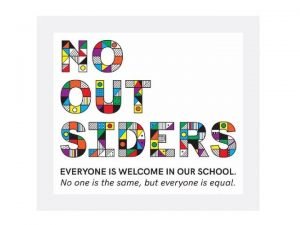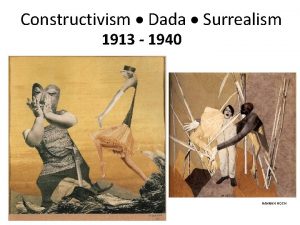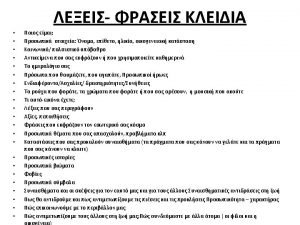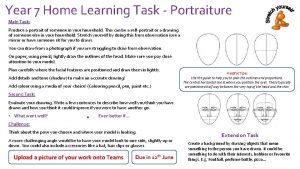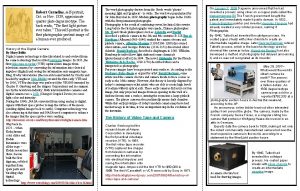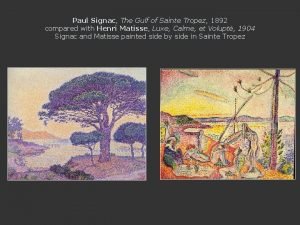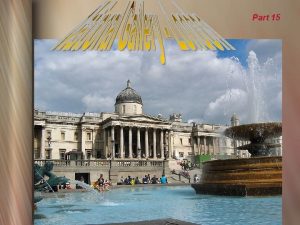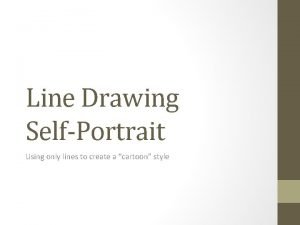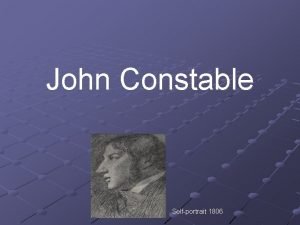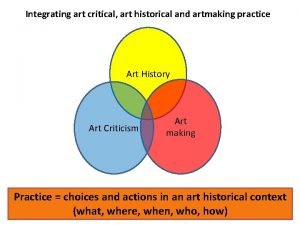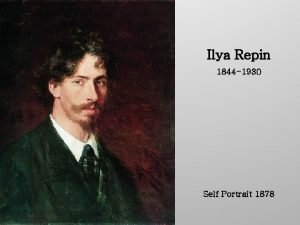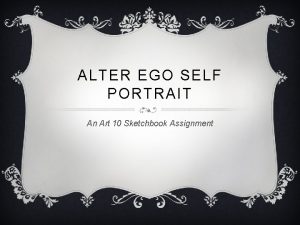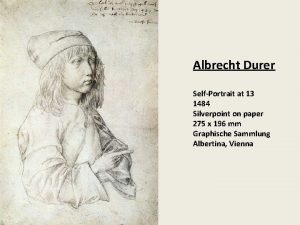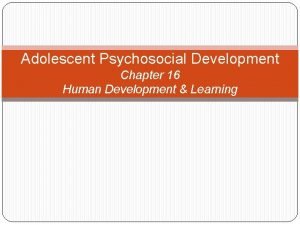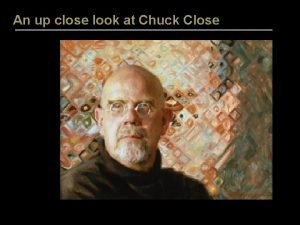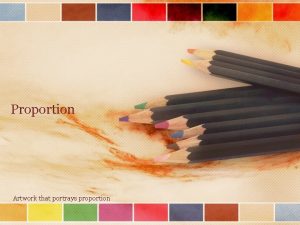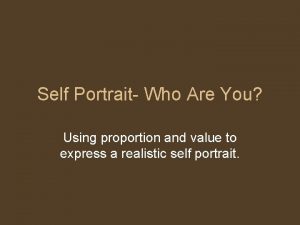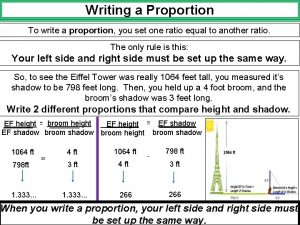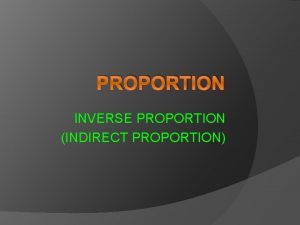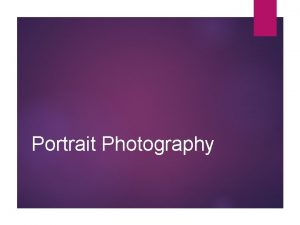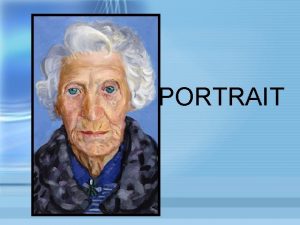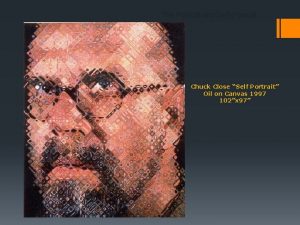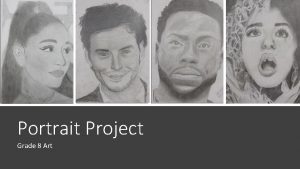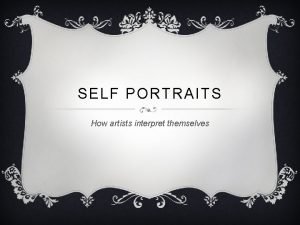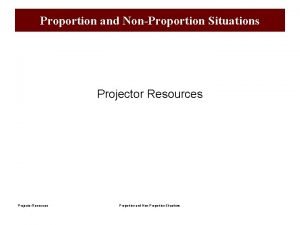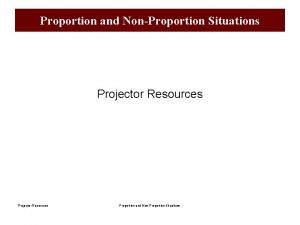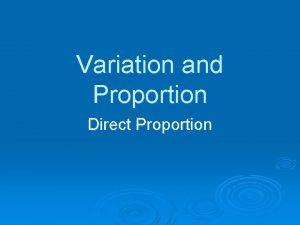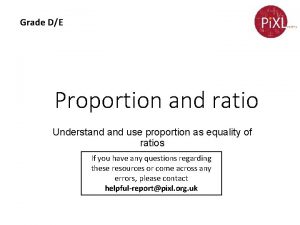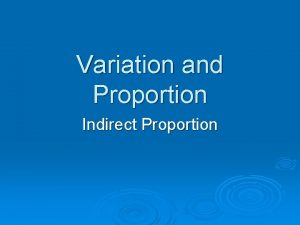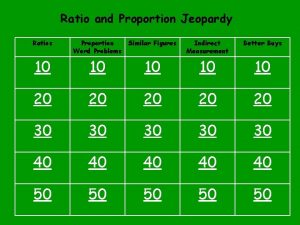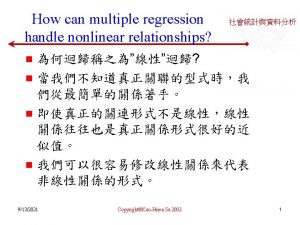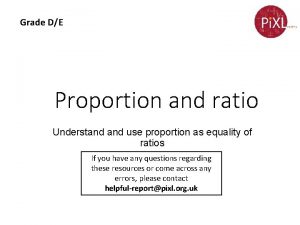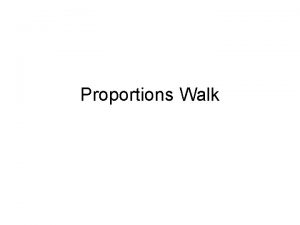Self Portrait Who Are You Using proportion and





































- Slides: 37

Self Portrait- Who Are You? Using proportion and value to express a realistic self portrait.

Leonardo da Vinci, Facial Proportion, and the Self-Portrait First Portion of Presentation Adapted From Presentations Created by Rock Ledge Elementary Fine Art Program, Seymour, WI Original Source: http: //www. seymour. k 12. wi. us/rle/art/grade_level_units. html

Mona Lisa • This painting is probably the most famous portrait in the entire world! • It was painted by an artist named Leonardo da Vinci. • Leonardo was a master at making his paintings look like the person he was trying to paint.

Leonardo Da Vinci • Leonardo once wrote, “Know the proportions in human beings and other animals and learn the forms of all things on the earth. The more you know, the better you will paint. ”

Leonardo’s Notebook • Leonardo was constantly taking notes about the world around him. He filled many notebooks with sketches of animals, people, and nature. • He took many measurements and was always trying to find a perfect balance so that his art had proportion.

Another Drawing from Leonardo’s Studies in his Notebook

What is Proportion? • Simply… – Proportion means that you make the parts fit well with each other. • More Specifically… – Proportion in art is the relationship between two or more elements. – When we talk about proportion in art works we are using comparing the size of one object in the artwork to the size of another related object in the artwork. You can also compare: • height, width and depth of the objects • size of one area to the size of another area • amount of space between two or more elements Good Proportion – Proportion is usually not even noticed until something is out of proportion. For example, if a person has a head larger than their entire body, then we would say that they were out of proportion. Out of Proportion

Other works with excellent Proportion:

The Self-Portrait: • Here’s a drawing Leonardo drew of himself as an old man. • A picture that an artist makes of him/herself is called a self-portrait.

Why the Self Portrait? • Subject is always changing • The model is cheap and close at hand • The concept is extremely challenging • Top l-r: Van Gogh, Picasso, Kollewitz • bottom: Rembrandt

Face Mapping • Face Mapping is a technique used to set up the proportion of the features on a face.

• By drawing lines that act as guides, you can figure out where parts go and how large they should be. • This will help make your face look more realistic. • With some practice, maybe you’ll be the next Leonardo da Vinci!

Let’s Begin… Self-Portrait Instructions Created By Mrs. O’Loughlin

Drawing your Self-Portrait: • Draw an oval in the center of your paper • How big should it be? • Your face is about the same size as your hand. • This doesn’t include your hair, just the face. • It is widest at your eyes, also about the same as your hand size

Drawing your Self-Portrait: • Now we’re going to draw some guidelines to help us map out our facial features. • Make sure to draw these lines lightly so they can be easily erased later on.

Drawing your Self-Portrait: • Line of Symmetry • Your face is symmetrical. • Everyone is not precise, but: • if you think of an invisible line drawn down the middle of your face the features on the right side are almost the same as on the left side. • Remember to draw lightly.

Eye Line • How many times has this happened to you when you have drawn a self-portrait? • An eye line is a guide that helps us to draw the eyes at the same height, size and proportion.

Drawing your Self-Portrait: • Eye Line • Contrary to popular belief your eyes are not on the top portion of your face. • Your eyes are located half way up or in the middle of your face. • Your face can be divided horizontally into thirds.

Drawing your Self-Portrait: Your face can be divided horizontally into thirds. • Eye Brow Line is at the end of that first third.

Drawing your Self-Portrait: • Eye Line • Let’s see what this guy would look like if his eyes were located on the top portion of his face…

Drawing your Self-Portrait: • Eye Line Yikes!!!

Drawing your Self-Portrait: • Eye Line • Draw your eye line half way up or in the middle of your face. • Also divide your face into thirds and draw the first third line curving it slightly. • This will be the eyebrow line. • Remember to draw lightly.

Drawing your Self-Portrait: • Eyes • What shape are eyes?

Drawing your Self-Portrait: • Parts of the eye Pupil = Black part of your eye, located in the center of your iris, allows light into your eye so you can see Tear Duct = Little pink bump where your tears come out Eyeball = White part of your eye Iris = Colored part of your eye Click here to learn more about the human eye: http: //kidshealth. org/kid/htbw/eyes. html

Drawing your Self-Portrait: • Proportion • Did you know your face is about five eyes wide? • Let’s test that theory on this guy again…

Drawing your Self-Portrait: • Yep! Five eyes wide! Eye’d win in a starring contest!!!

Drawing your Self-Portrait: • Eyes • Look at your eyes in a mirror. • Using the eye line as a guide draw the outside shape of your eye. • Remember your eye is a ball. We only see the front of the ball

Drawing your Self-Portrait: • Eyes • Now carefully erase your eye line.

Drawing your Self-Portrait: • Eyes • Looking at your eyes in a mirror draw your iris, pupil, eyelid, and any other lines or qualities that make your eye unique. • Iris • Colored Part • Circle • Usually hidden on the top or bottom by the eyelid • Pupil • Black • Circle • Center of Iris

Eyes Express Emotions • Show emotion or expression • Can you tell what emotions this person might be feeling by just looking at her eyes and eyebrows? • The concept of this assignment is to express who you are. • If you don’t get the eyes right it won’t happen.

Noses • The edges of your nose fall under the inside corners of your eyes. • Your nose is located in the middle third of your face. Depending on your nose size it may extend to the end of that third or end just before it. • It sticks out furthest on your face, therefore it is the lightest when shading. • The skeletal structure defines the shading.

Parts of the Nose • Look at your nose in the mirror. • How are the parts of your nose shaped? • What makes your nose unique? • Skeletal structure defines the nose.

Drawing your nose • Draw what you see in the mirror. • Remember make your nostrils oval or elliptical shape. NO PIG NOSTRILS! • Also remember the bridge of your nose isn’t connected to your eyebrows with a line. • It’s all about shading!

The Mouth • Very expressive facial feature • Look again at this photo. The mouth changes shape with each emotion or expression. • The whole face shifts as the emotions change.

Drawing your Self-Portrait: • Mouth and Proportion • The corners of your lips fall under the pupils of your eye. • The mouth is soft and made up of a series of connected ovals and rounds • Your mouth is around the same size as your eye.

The Mouth • Draw your top and bottom lips to create your mouth. • Draw what you see in the mirror. • The top lip is always slightly darker than the bottom because of the shadow of the nose. • It is a series of curving parts connected through shading.

What about the rest? • Neck, ears, hair, shoulders? • Neck starts behind your ears • Shoulders support the head so they must be wide enough • The ears are in the middle third of your face (eyes and nose too!) • Hair sits on top of your head and must convey the texture and style of yours • It’s not just flat!
 Antigentest åre
Antigentest åre Differentiation of self
Differentiation of self Self portrait proportions
Self portrait proportions Self-portrait with beret and gold chain
Self-portrait with beret and gold chain Andy warhol campbell soup
Andy warhol campbell soup Zentangle self portrait
Zentangle self portrait Picasso self portrait
Picasso self portrait Torn paper drawing
Torn paper drawing Albrecht durer self portrait in a fur collared robe
Albrecht durer self portrait in a fur collared robe Charcoal self portrait
Charcoal self portrait Frida kahlo self portrait with monkey 1940
Frida kahlo self portrait with monkey 1940 Mc escher self portrait
Mc escher self portrait Self portrait (5)
Self portrait (5) Oleg shuplyak freud voyeur
Oleg shuplyak freud voyeur Self-portrait with eyes turned inward, boston
Self-portrait with eyes turned inward, boston Michelangelo born
Michelangelo born Michelangelo buonarroti self portrait
Michelangelo buonarroti self portrait Lucian freud queen elizabeth ii
Lucian freud queen elizabeth ii How to draw ears on a self portrait
How to draw ears on a self portrait Impressionist self portrait
Impressionist self portrait Hannah hoch the painter
Hannah hoch the painter 크리스티앙 볼탕스키
크리스티앙 볼탕스키 Learning task 7 draw a simple map
Learning task 7 draw a simple map Self portrait composed of many pieces
Self portrait composed of many pieces Self portrait composed of many pieces
Self portrait composed of many pieces Robert cornelius self portrait
Robert cornelius self portrait Paul signac self portrait
Paul signac self portrait Carlo crivelli self portrait
Carlo crivelli self portrait Line drawing self portrait
Line drawing self portrait John constable self portrait
John constable self portrait Kieran hall self portrait
Kieran hall self portrait Repin self portrait
Repin self portrait Alter ego self portrait
Alter ego self portrait Durer self portrait 1484
Durer self portrait 1484 Self portrait composed of many pieces
Self portrait composed of many pieces Chuck close self portrait 1977
Chuck close self portrait 1977 Chuck close childhood
Chuck close childhood Self portrait
Self portrait


